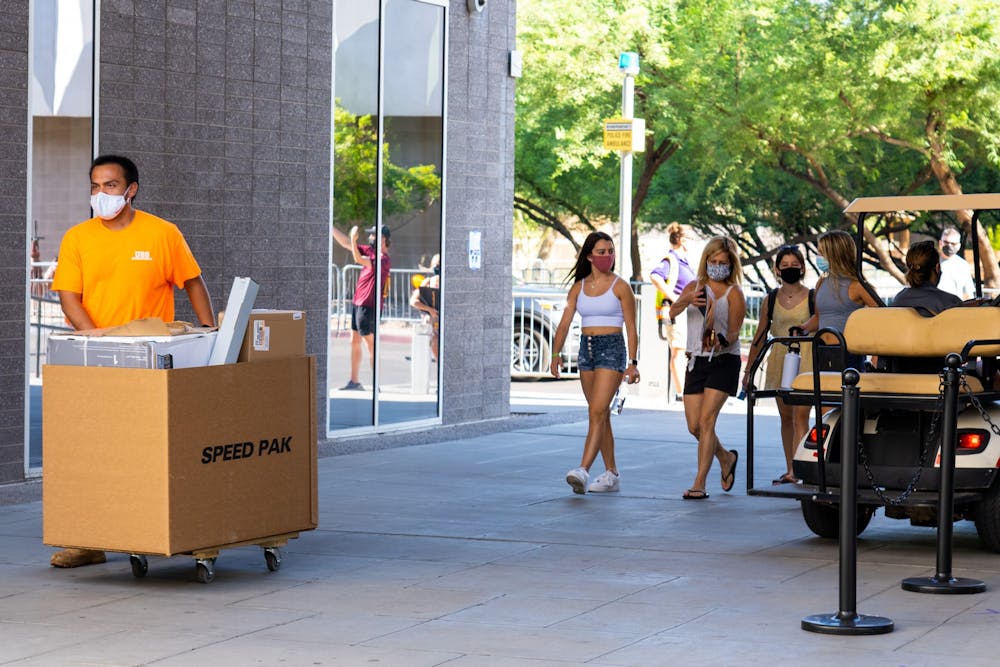Leading up to the Fall 2020 semester, incoming students felt ASU advertised a relatively normal college experience: They could be on campus, go to in-person classes and attend some events.
Instead, the semester “was kind of like the death of a dream,” said Ellie Goeringer, a freshman studying nursing, who ended up having an atrial fibrillation heart attack after getting COVID-19 while living in the dorms.
Students quickly realized few, if any, of their courses would be in-person and on-campus activities would be sparse due to COVID-19 concerns, with Arizona being one of the worst hot spots in the country.
“I was paying so much money just to sit in a room by myself on a computer,” said Paris Merrill, a freshman studying exploratory health, who moved out of her dorm during the fall semester.
Merrill and Goeringer, like 1,660 other students so far this academic year, would submit and have a License Agreement Release form approved by University Housing to move out of their dorms, pay a $500 cancellation fee and receive a proration of room and board.
According to data provided by a University spokesperson, 1,332 LARs were approved for the previous 2019-20 academic year.
Thousands more have moved out without filing a LAR or who have left without being approved first, according to the number of students living on each of ASU’s campuses posted each week in the University’s COVID-19 updates and tracked by The State Press.
On Sept. 10, 12,157 students lived across the Tempe, Downtown Phoenix, West and Polytechnic campuses. As of Monday, 8,760 lived across the four campuses. It's possible some students have not yet returned to their dorm for the spring semester.
Since ASU only publishes the total number of students currently living on campus because of COVID-19, there is no comparison for the 2019-20 academic year outside of official LAR documentation.
The reality of on-campus living
The students who moved out knew COVID-19 would impact their semester, but in interviews with The State Press, those who have left said they were surprised by the lack of compliance many students had for health guidelines as well as ASU’s poor enforcement of them.
“Every day, me and all my friends were like, 'Is this the day that I'm going to get COVID?'” Goeringer said.
After the first few weeks living on campus, Goeringer got the coronavirus despite taking what she said were appropriate precautions. “One day I just started feeling a bit weird, I went to bed. The next morning, I could barely stand,” she said.
Her parents made her go home to be with them. Soon, COVID-19 would send her on three trips to the emergency room: The first two were “because I legitimately just couldn't breathe,” she said, and the third was due to an atrial fibrillation heart attack.
“COVID completely destroyed me,” Goeringer said. “I was so desperate to get back to campus and try and be social. Everyone's just saying to try and ASU is saying just try harder, but there's a point when you need to stop trying because it is hurting you.”
Haley Moore, a freshman studying nursing who moved out of her dorm, said the University “painted this picture that everything was going to be under protocol" by asking students to follow the guidelines of wearing masks, practicing social distancing and more.
However, soon it was clear students would not follow those guidelines; some would go out to parties and then get COVID-19, Moore said.
Then, students who were infected would leave their dorms and go out.
READ MORE: Palo Verde West desk assistants encounter students with COVID outside of isolation
That lack of compliance — and no transparency from the University on where cases were in the dorms — would then lead many to choose to not attend classes in person due to their fears of being exposed to the coronavirus.
Around 20% of students chose to be on campus each day in the fall, according to President Michael Crow in a meeting with The State Press on Dec. 2. For the spring semester, the University is pushing to have more in-person opportunities for students and giving faculty less flexibility to teach remotely, even as coronavirus cases are higher in Arizona than at the start of the last semester.
The Arizona Department of Health Services reported 4,854 newly reported cases and 262 deaths Wednesday. On Monday, ASU reported 775 active COVID-19 cases within the ASU community and has reported 5,604 cumulative cases since Aug. 1.
Jenna Bourgogne, a freshman studying nursing who moved out of the dorms, said the only way she knew if other students living on her floor had COVID-19 was by seeing the brown paper bags filled with food left outside their room.
She said she would then worry about whether she had ever run into that person on an elevator or if she should even go to her in-person class or to the dining hall to get food.
Some experiencing long delays in a decision
By Sept. 20, one month after classes began, over 600 students were approved to move out of the dorms to receive a proration of their room and board and not incur any charges in the spring for housing or dining.
Goeringer and Merrill said during that time they were able to list the pandemic and their fears of the virus as their reasons for filing their LARs, which were quickly approved.
As of Jan. 14, 1,081 LARs have been approved since Sept. 20, but students who filed after the date said they were often denied, even if they submitted their LAR for COVID-19 reasons.
Bourgogne said she was denied when she filed her initial LAR citing COVID-19 concerns. She then reapplied and provided medical documentation from her primary care doctor. She was approved Jan. 19 after applying on Dec. 15.
Moore moved out of her dorm in October and said she was denied when she initially filed her LAR. She submitted a LAR again in December, citing COVID-19 concerns and her high-risk family members, and has yet to get a response from the University.
Since Sept. 20, University Housing is making decisions on a “case by case basis and the Housing team is reviewing each LAR, giving each request individualized attention to make a decision with that specific student situation in mind,” a University spokesperson wrote in an email.
The spokesperson wrote that University Housing does not keep track of the number of LAR submissions it receives and could not provide an answer on how many are still pending a decision.
According to the LAR website, students have until 5 p.m. Feb. 11 to be considered for release and "not incur housing and dining charges for the Spring 2021 semester" if approved.
“They should just be automatically approving students because we’re in a pandemic,” Moore said. “And the school's not being responsible enough to keep the students on the campus in the first place and making them feel like they're in a safe environment.”
Managing editor Greta Forslund contributed reporting to this article.
Clarification: Following a clarification from the source, the story has been updated to clarify the type of heart attack she experienced.
Reach the reporter at wmyskow@asu.edu and follow @wmyskow on Twitter.
Like The State Press on Facebook and follow @statepress on Twitter.
Continue supporting student journalism and donate to The State Press today.

Wyatt Myskow is the project manager at The State Press, where he oversees enterprise stories for the publication. He also works at The Arizona Republic, where he covers the cities of Peoria and Surprise.




